https://www.navyrecognition.com/index.p ... rials.html
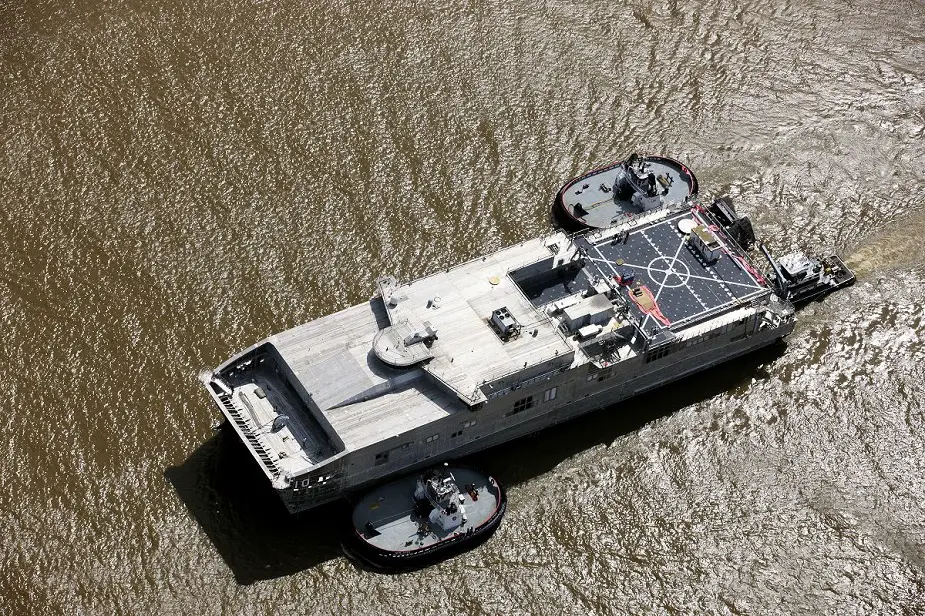

ith its shielded electronics and underground levels, the C2F and at least some of its occupants might survive the initial blasts in a nuclear war. "But I doubt it would last long in a later exchange," Kristensen said. "A couple of direct hits with high-yield warheads would likely shake the underground structure to pieces."
"Nuclear command and control today is less dependent on super-secure underground facilities, but in a flatter architecture than makes use of numerous redundant and dispersed facilities," Kristensen said. "So an adversary could blow up Offutt, but by that time the national command leadership would be long gone and it wouldn’t prevent [Strategic Command] from retaliating or continuing the fight, if one can imagine that in a nuclear war."
.An integrated team from the Boeing Co. and the U.S. Air Force have cleared the final flight tests required for first delivery of the KC-46A Pegasus tanker. The first delivery of the tanker is planned for late October, and will go to McConnell Air Force Base in Wichita. “With this milestone complete, the test program has demonstrated a level of maturity that positions Boeing to deliver, and the Air Force to accept, an aircraft by the end of October 2018,” Will Roper, the Air Force service acquisition director, says in an article published Friday morning on the USAF website. The service says recent tests involving the aircraft’s Remote Vision System and receiver certifications of the F-16 Fighting Falcon and C-17 Globemaster combine with previous testing activity to achieve the minimum flight testing requirements for first delivery. The tanker program is now moving on to additional receiver aircraft testing and certifications for operational testing to begin in 2019. Boeing (NYSE: BA) plans to build 179 of the new tankers for the USAF, which will begin updating the service’s aging fleet of Eisenhower-era KC-135s. The program also represents production work in Wichita, where the city’s largest employer, Spirit AeroSystems Inc. (NYSE: SPR), builds the forward fuselage and other components on the 767 model that serves as the tanker’s platform
SaiK wrote:Watchdog Says USAF Is Wasting F-22s On Patrols And Deployments, Should Consolidate Force
http://amp.timeinc.net/thedrive/the-war ... source=dam
Supposedly the USN had developed variable yield nukes that could be programmed to detonate either as tactical or strategic nukes with varying yields to suite the battle circumstance. That would enable a tailored response to an attack.Prem wrote:https://www.popularmechanics.com/milita ... r-weapons/
U.S. Submarines Will Soon Carry Tactical Nuclear Weapons
The U.S. Navy’s fleet of ballistic missile submarines will soon carry tactical nuclear weapons, as Congress prepares to fund development of a new, low-yield nuclear
The U.S. Air Force has revived a decade-old concept for a new version of the AGM-158 joint-air-to-surface standoff missile (Jassm) with potentially five times more range than the original version.
Lockheed Martin received a $51 million contract on Sept. 10 to plan and schedule development of an “extreme range” version of the missile dubbed Jassm-XR.
All work under the new contract, which includes a new missile control unit, should be complete by Aug. 31, 2023, the Defense Department says.
Lockheed’s tactical missile unit in Orlando, Florida, first unveiled a concept for an ultra-long-range Jassm-XR in 2004.
A 2009 report by the Defense Science Board (DSB) described such a weapon as designed with a range up to 1,000 nm.
By contrast, the merely extended-range version of the missile, designated as the AGM-158B Jassm-ER, is listed with a range of more than 500 nm. The original version of Jassm has a listed range of more than 200 nm. Lockheed has also designed a version of the Jassm-ER for the U.S. Navy, which is called the long-range anti-ship missile (LRASM).
Most likely longer and heavier than previous versions of the missile, the Jassm-XR is designed for launch from bombers and heavy strike aircraft, the DSB report says.
Such a weapon would add a new subsonic cruise missile that bridges the gap between the range of the AGM-158B and the 2,400 nm endurance of the Boeing AGM-86 conventional air launched cruise missile.
If the Jassm-XR retains the stealth features of the original version, the new weapon would come close to matching the range and low observable characteristics of the Raytheon AGM-129A, a nuclear-capable cruise missile that the Air Force retired in 2012 without a replacement.
While still in service, six AGM-129As could be loaded on each of two pylons under the wing of a Boeing B-52H, allowing each bomber to carry a total of 12 missiles.
Long foreseeing this moment, when adversaries break its decades-long monopoly on the technology, the US Department of Defense has been working to find ways to test its ability to spot and shoot down stealth aircraft. One part of that effort is the Director of Operational Test and Evaluation (DOT&E) office’s development of a fifth-generation aerial target (5GAT), a full-sized stealth unmanned air vehicle.
Typically, the DoD gives its stealth aircraft development to multibillion dollar prime contractors such as Boeing, Lockheed Martin or Northrop Grumman. But not in this case, as responsibility for this aircraft has fallen into the hands of a little-known aerospace start-up named Sierra Technical Services.
Empowering a small start-up is exactly the point, actually.
The “goal for the 5GAT effort, as a proof of concept, is to assess the ability to conduct a rapid prototyping and experimentation to enable the fielding of a low-cost, all composite, full-scale, unmanned target that delivers the requisite performance and mission capability at a fraction of the cost of current target programmes,” says the DOT&E. “The 5GAT contract award occurred in March 2017. Its maiden test flight is scheduled to occur only 26 months later, in May 2019.”


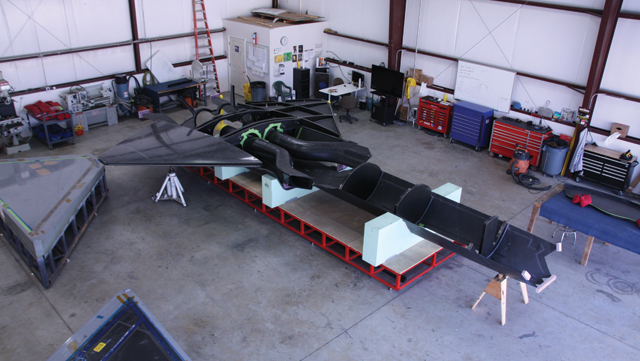
GE XA 100 -Progress toward adaptive-cycle combat engines for future U.S. fighters is accelerating, with first components delivered for prototype three-stream demonstrator engines, and new contracts awarded for the development and testing of technologies for flight-weight adaptive engines.
Parts for General Electric’s XA100 have begun to arrive at the company’s Evendale, Ohio, facility, while both GE and Pratt & Whitney have secured additional work to evaluate suites of variable cycle, thermal management and other technologies aimed specifically at all-new combat aircraft concepts for the 2030s and beyond.
Adaptive engines are a new class of combat propulsion systems that will use variable inlets, valves and ducts to modulate an additional bypass flow, or third stream. This flow can be employed to increase thrust or, alternatively, increase range by improving cruise efficiency. Adaptive propulsion has become a baseline requirement in next-generation Air Force and U.S. Navy combat aircraft studies, and mastery of the technology forms a key part of the Pentagon’s drive to maintain U.S. air superiority in the 21st century.
The work is being conducted under the U.S. Air Force’s Adaptive Engine Transition Program (AETP), a broadbased initiative launched in 2016 to mature variable-cycle technology for sixth-generation fighters as well as, potentially, provide a future reengining option for the Pratt & Whitney F135-powered Lockheed Martin F-35. The program, which also leverages earlier variable-cycle testing conducted under the Air Force Research Laboratory’s Adaptive Engine Technology Development program (AETD), is initially focused on demonstrators in the 45,000-lb.-thrust range.
Even as GE works on the XA100 demonstrator and Pratt develops its virtually identically sized XA101 counterpart, both are also now working on additional clean-sheet adaptive engine concepts specifically for sixth-generation designs. Awarded as modifications to the original AETP program agreement, the contracts for this new work cover a broader application of other advanced engine technologies—including three-stream architecture—and go beyond the limiting confines of the F-35-centric XA100/101 demonstrators.
Announced on Sept. 7, the $437 million Air Force Life-cycle Management Center contract award to Pratt follows an earlier agreement signed with GE for the same amount in late June. The deals enable each engine-maker to exploit a “suite of technologies,” says Dan McCormick, general manager of GE’s Advanced Combat Engine program. In GE’s case, “these include the adaptive engine architecture but also areas like ceramic matrix composites, additive manufacturing and high compression compressors,” he says. “So [there is] a tool kit of technologies we have been maturing through AETD and AETP.”
Pratt says that “along with a demand-modulated engine architecture,” the company “is also maturing an adaptive technology suite that includes control systems as well as power and thermal management systems to enable enhanced range, persistence, survivability and maintainability capabilities for advanced weapon systems.”
The work is “really to validate these suites of technologies and, although mixed differently and maybe with different sizes of engines, they would go into a family of aircraft going forward,” adds McCormick. “From a timing sequence, the F-35 was ahead of the sixth-generation process, and the Air Force is now stepping through the process of figuring out what the requirements are going to be for that next-generation aircraft, which then informs the propulsion requirements. So we started down the F-35 path with the AETD in 2012 and are really just starting the early phases of looking at these technologies and sizing engines for the next generation.”
While the XA100/101 designations have been applied to F-35-size engines, “there is not a name yet for what might be a next-generation derivative engine, because we are still in the early phases of what that might look like,” McCormick says. As the size and configuration of the potential follow-on combat engines is likely to differ considerably from the initial adaptive demonstrators, these later engines are unlikely to be defined as derivatives in the same way current military turbofan families do.
“We don’t really think of what we are doing under this new contract necessarily as a derivative of the XA100. It is really taking the suite of technologies and figuring out how we mix them differently,” says McCormick. Variation may be driven by different mission requirements and even whether the application is a single- or twin-engine design as defined by typical parameters such as range, maximum acceleration and Mach number, he explains.
The Air Force, which has ordered three each of the XA100/101 prototype demonstrators from GE and Pratt respectively, has previously laid out a more conventional derivative path for AETP in which scaled core versions could potentially reengine aircraft such as the F-15 and F-22. A scaled common-core AETP derivative could meanwhile be offered for sixth-generation Penetrating Counter Air and Next-Generation Air Dominance combat aircraft concepts.
Parts for the first XA100, engine 001, are meanwhile starting to arrive at GE’s Evendale facility. “We are starting at ground zero, but the supply chain is off and running, and we have hundreds of parts in the system. A couple of weeks ago we received our first finished part,” says McCormick, who adds that most of the early components are long-lead items such as forgings and castings.
Assembly is due to take place through 2019, with testing expected to begin by early 2020. The Air Force has meanwhile exercised “option one” of the AETP contract, under which it will install a test-cell XA100 engine in an F-35 for ground evaluation. There is currently no plan to flight-test the engine, which has been designed to fit inside the F-35A conventional-takeoff-and-landing variant as well as the F-35 carrier variant. The XA100 is incompatible with the lift system on the F-35B and therefore will not be available for testing on the short-takeoff-and-vertical-landing variant.
Based on component, rig and core tests undertaken to date, McCormick says the company is “comfortable” the XA100 would meet the thrust, range and thermal management requirements if the initiative evolves into a full-up development program. “The thrust objective was 10% growth, and today we exceed those requirements,” he explains. Lockheed Martin and Honeywell, which is the developer of the F-35’s integrated power package, have also verified the improved thermal management system (TMS) through analysis. Targeted TMS improvement is an increase of more than 160% efficiency, which would result in more than doubling the F-35’s current low-altitude dash time.
The requirements also call for a 30% increase in range over the current aircraft. “Probably range is where we are most challenged. It’s a pretty high bar, and we believe we can get there,” says McCormick.”

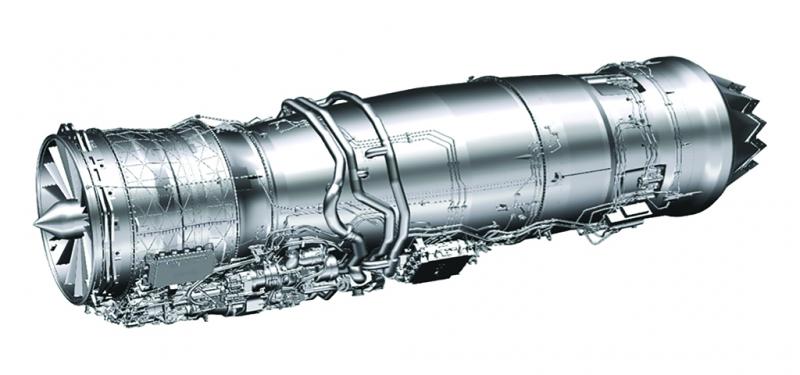
You know you are truly living in a flush defense budget era when the Secretary of Air Force can present an initiative to massively expand service's force structure, going from 312 squadrons today to 386 by 2030, with a straight face. This is an increase in overall size of nearly 25 percent. Just a couple years ago the USAF couldn't even afford the fleet it already had yet alone the one it planned to procure. Now it wants to execute the biggest end-strength expansion since the Cold War.
That justification is up for debate, but Secretary Wilson is right, the USAF needs more capacity, at least in certain areas, to meet even current demands. Over the last decade and a half, the force as a whole has shrunk continuously to become just a shadow of what it was during the invasion of Iraq in 2003, let alone what it was during Desert Storm over a decade earlier. In 30 years, the number of fighter squadrons the service has on hand alone has dropped by 59%, from 134 to just 55.
And from the Air Force MagazineThe cold hard truth is that you can have the best aircraft in the world, but they can only be in one place at one time, and that place is as often as not sitting broken on the ground.
Specifically, USAF wants five more bomber squadrons; seven more space squadrons; 14 more aerial refueling squadrons; seven more special operations squadrons; nine more combat search and rescue squadrons; seven more fighter squadrons; two more remotely piloted aircraft squadrons; one more airlift squadron; and 22 more command and control and intelligence, surveillance, and reconnaissance squadrons.
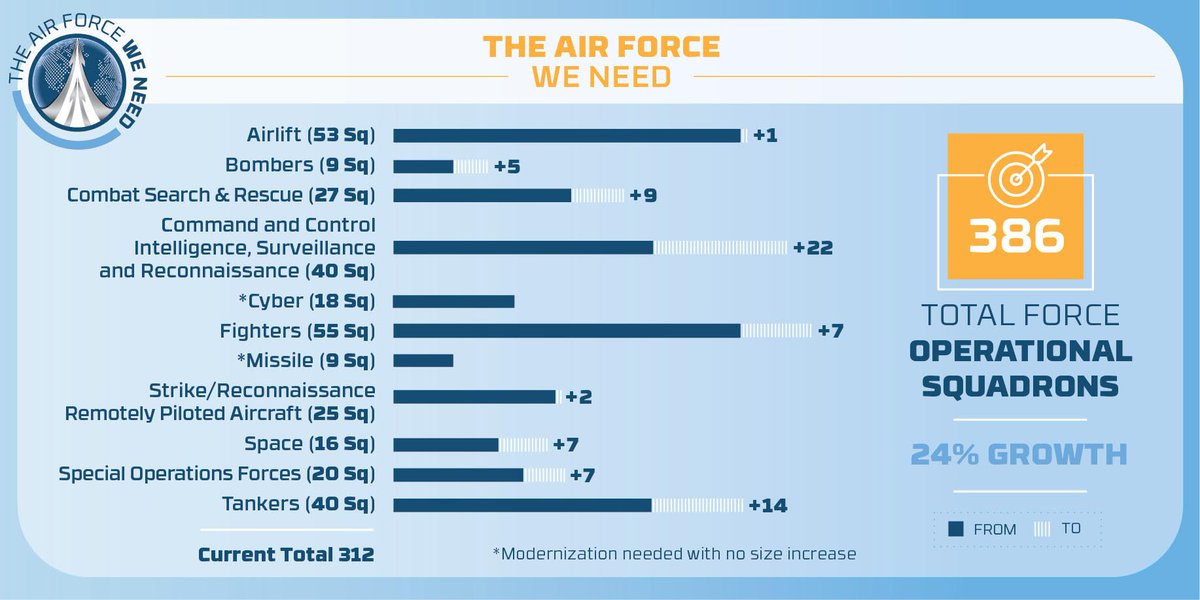
Marines training on the ground on the Horn of Africa will see a new set of wings pulling the classic close air support mission: The F-35B Lightning II Joint Strike Fighter...FULL ARTICLE LINKED ABOVE
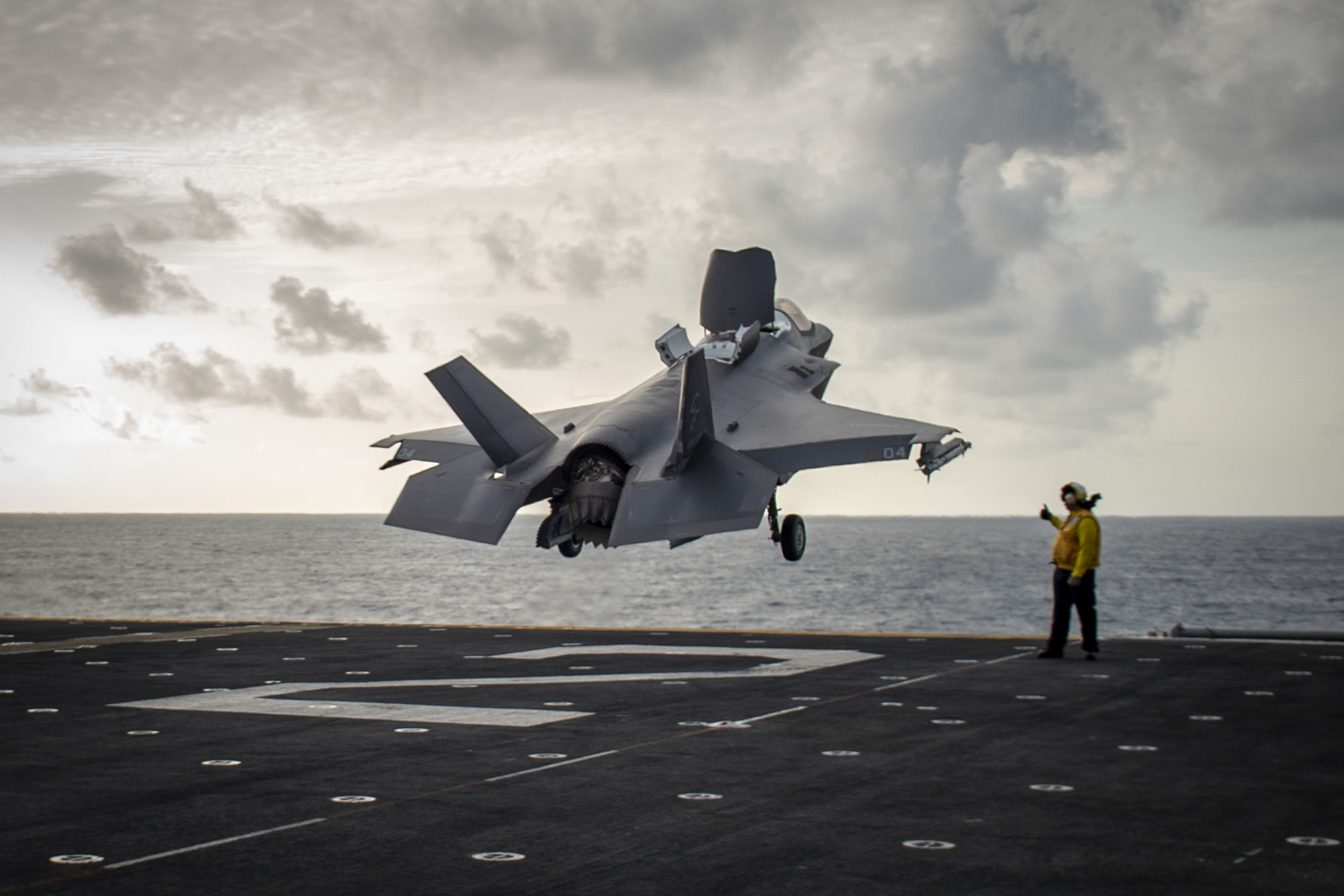
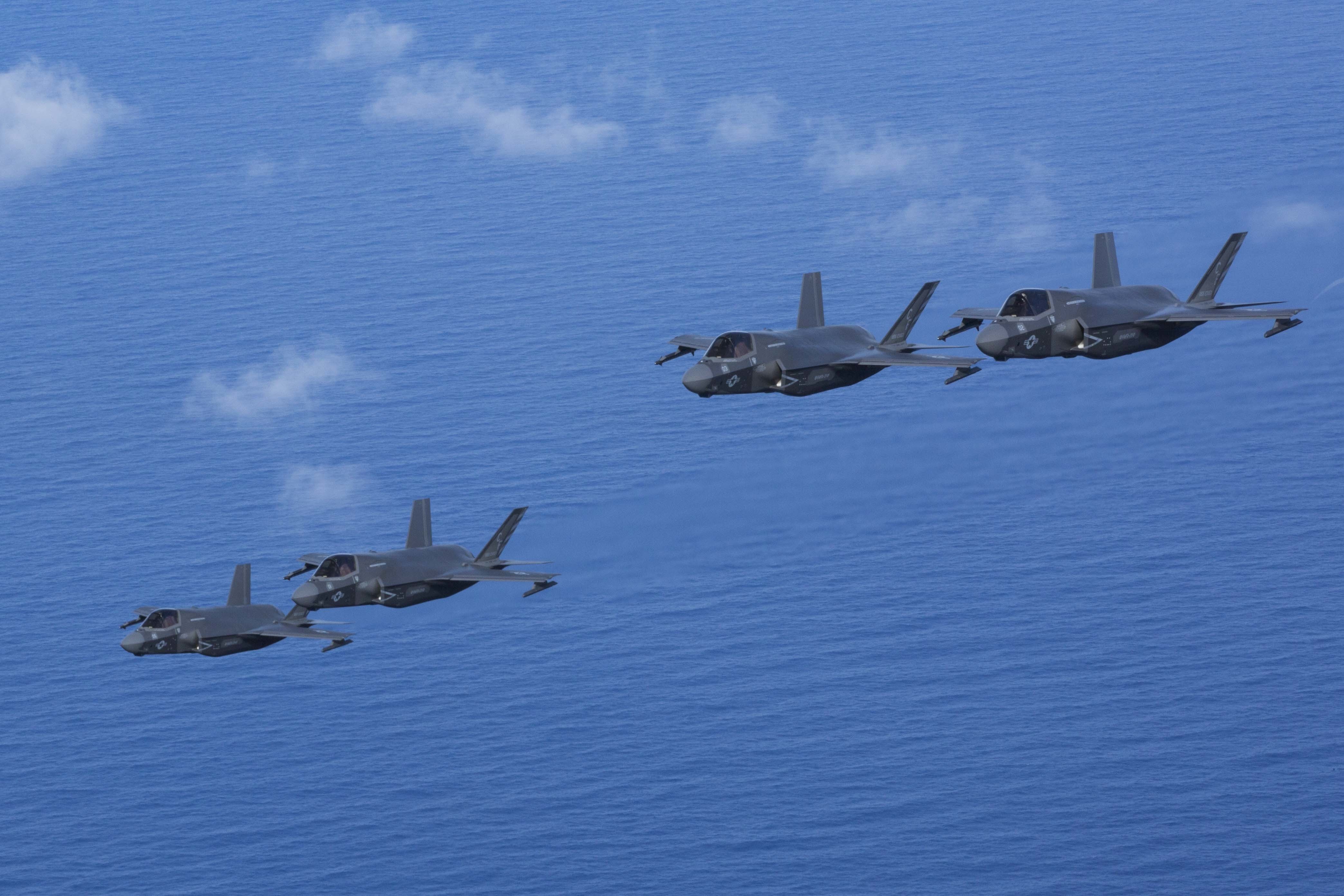
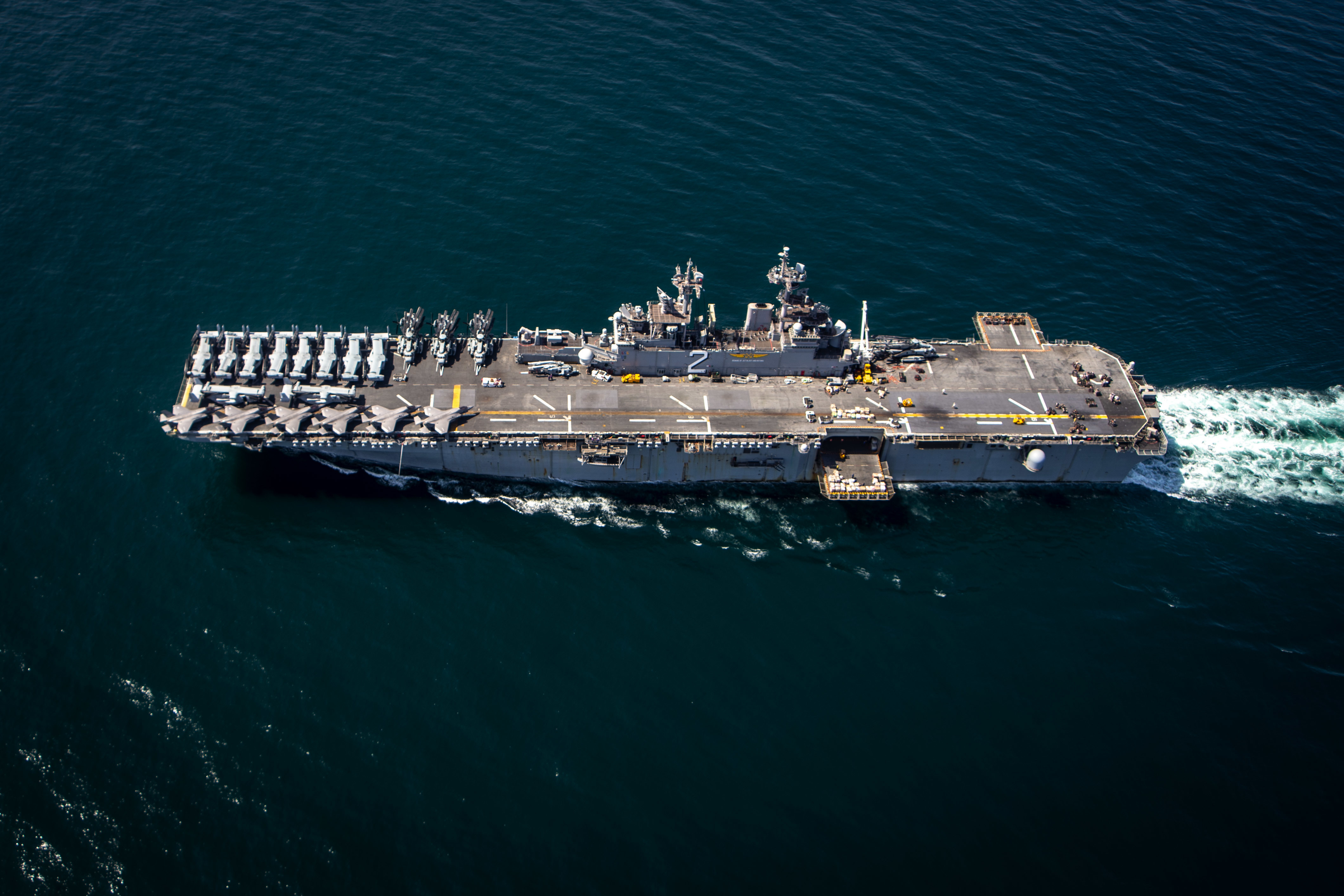

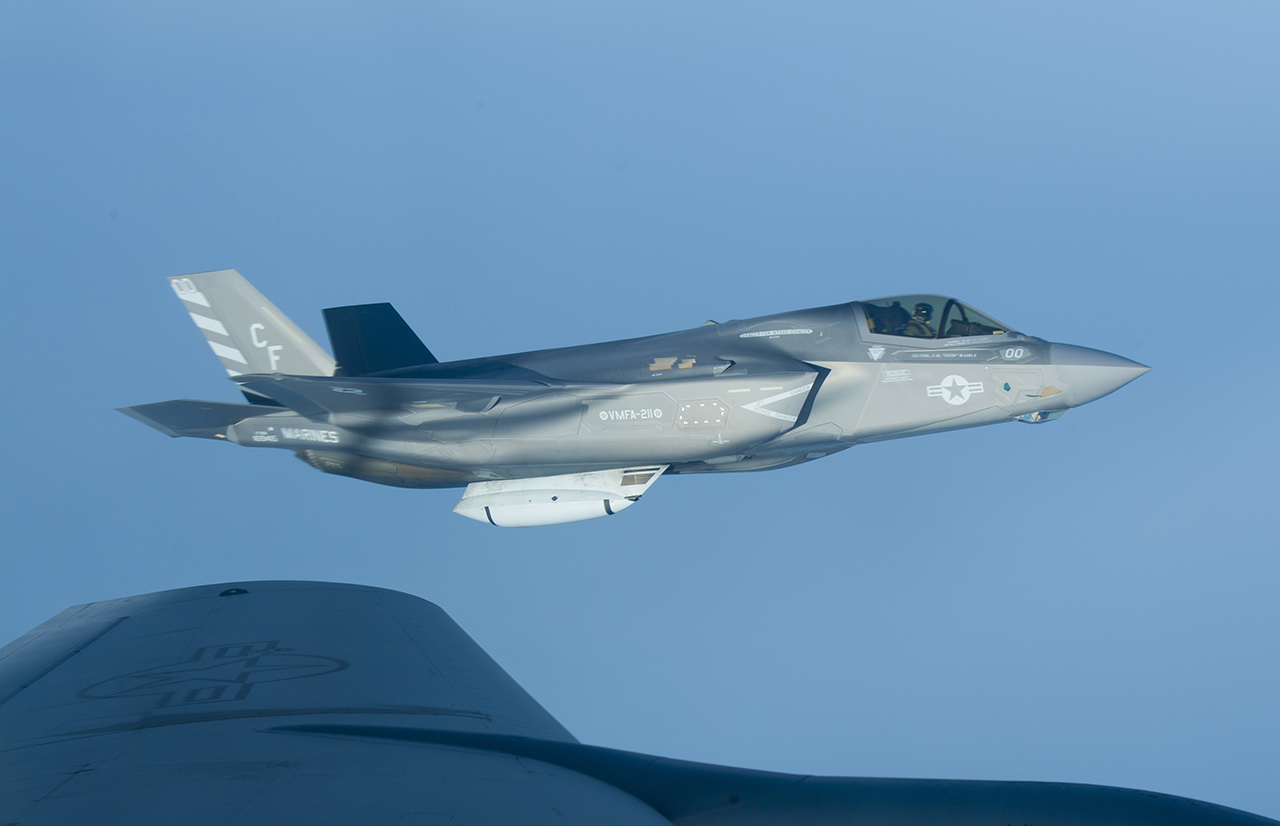
^ A U.S. Marine Corps F-35B Lightning II assigned to the Marine Fighter Attack Squadron 211, 13th Marine Expeditionary Unit, flies alongside the wing of a KC-135 Stratotanker assigned to the 28th Expeditionary Air Refueling Squadron after receiving in flight fuel during an aerial refueling mission near the Horn of Africa, Sept. 15, 2018.
Here are some screengrabs from the paper Dr. Frey presented at AIAA earlier this year -The F-35’s calling card is being a mobile sensor package that can improve the effectiveness of an entire fleet by sharing data and coordinating information such that the situational awareness of every warfighter present is increased exponentially.
Making good on that promise has been a rocky endeavor, but the potential has kept the program a priority. Lockheed and the military are now happy with what it enables: Costs are coming down, reliability and production are up, and pilots can use the cutting-edge sensor suite to maintain tactical advantage and respond to threats in a wide variety of situations.
Lockheed Martin fellow and Information Fusion Chief Scientist Thomas Frey provided an example of how the fighter fuses multiple pieces of data into useful information at June’s AIAA Aviation Forum in Atlanta.
He explained, if there were 35 aircraft near an F-35, the infrared sensor could detect all of the them and the direction they are in by heat signals, but has no way to tell who is friend or foe. The electronic warfare systems may pick up 22 of the 35, giving additional information about those. Six of the 35 are within the Doppler radar’s field of view, giving a clear picture of those six.
The F-35 also incorporates data sent from air- and ground-based allies. That helps sort friend from foe and provides angle and range data originating from different points. With that, the system will automatically triangulate a target’s geolocation from multiple sources who picked it up.
Once all of that is incorporated, the fusion engine can combine it into one picture of the battlefield that it displays to the pilot, identifying the location and distance of all 35 targets and which are foes. The autonomous sensor manager assigns a percentage to how confident it is in each of its determinations.
At the same time, it’s constantly rechecking each of those determinations and sending data into a network for other aircraft to use while doing the same thing. One important distinction is that the final map of information it comes up with after all that combination is referred to as Tier 3 data: incorporating everything the F-35 observed as well as everything it received from allies, what Frey calls “rumors.”
The F-35 sends Tier 1 data it has collected with its own sensors to allied battlefield networks. That way, each jet is only feeding the network with firsthand, reliable information. Then the others, and the network as a whole, can be the source of new Tier 3 data without being muddied by compounding rumor data that may or may not have been reliable.
Testing shows that this is important to create the clearest final information and strongest conclusions: Frey said blind-firing missiles based on shared targeting data has been successful in tests.
This method of data collation also lets each machine use the data as it sees fit since depending on where a jet is on the battlefield, different targets and actions need to be prioritized.
If a target is nearby, the system automatically makes it a high priority and focuses sensors and processing power on accurately determining the nature and location. The sensor knows the pilot will imminently need to make decisions about the target. If the same target is farther away, it might be lower priority, so it doesn’t receive the same prominence.
Further, while this all happens under the surface, pilots can interact and request certain information, targets or focuses if they so choose. In those cases, it’s helpful if the system has the raw data every F-35’s sensors collected rather than the impressions the F-35 already synthesized that data and the rumors it has received into.
To handle the necessary bandwidth, the F-35 has two primary data-sharing channels: the multi-function advanced datalink (MADL) network and Link 16.
“For MADL, you can best think of that as a way to extend one avionics system into multiple aircraft,” said Greg Lemons, Lockheed Martin’s missions systems expert for the F-35. “It’s designed around a four-ship flight group to be able to exchange the data that each aircraft sees, and for each airplane to take that data and fuse that into the information for the pilot.”
MADL allows greater, faster data sharing than other systems and is difficult for enemy forces to jam. The downside is it’s designed solely for communication between F-35s. The B-2 Spirit bomber is MADL-compatible. There were plans to upgrade the F-22 Raptor, but they were scrapped. The U.S. Defense Department has talked of upgrading other aircraft to MADL, but it’s expensive and cumbersome.
The legacy Link 16 system has wide compatibility. Lemons said that unlike most platforms that simply have a Link 16 communication box on board, the F-35 flies with a receiving box to see what other aircraft would receive from the fifth-gen fighter.
“On Link 16, you have to understand how the other platform uses your data and processes it so you can send it to them in a way that is meaningful to them,” he said. “The challenges were more associated with how the other platforms would interpret our data and making sure what we sent them provided them good information rather than information they couldn’t use because of how it was formatted.”
F-35: Is The Trillion-Dollar Fighter Finally Worth It? - F-35: http://interactive.aviationtoday.com/av ... -worth-it/
F-35 Data Fusion: How the Smartest Fighter Shares What it Sees - https://www.aviationtoday.com/2018/09/0 ... ta-fusion/
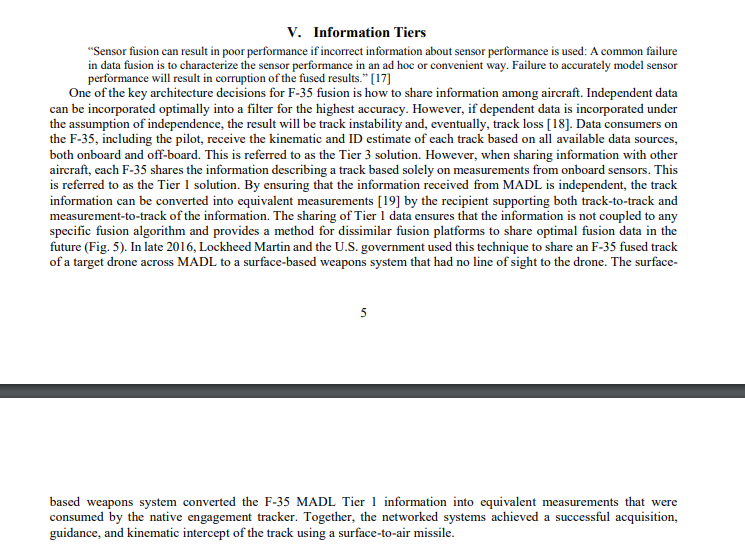
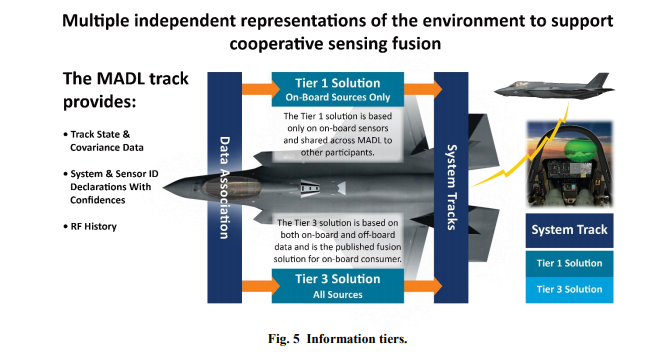
- The Evolution of Fusion Technology
The first radar was introduced to a fighter in the mid-1940s. As confidence grew in this technology, pilots came to
rely on the radar to provide situational awareness in the environment. A radar warning receiver was later added to give
a coarse indication of the general direction of a hostile emitter. In the 1970s and 1980s, new sensors and datalinks
added secondary sources of ranged tracks. This ushered in the initial generation of fusion technology, which used data
association or correlation algorithms to identify tracks that most likely described the same object in space and then
suppressed all except the most accurate copy of the track from the display (Fig. 2). This is sometimes referred to as
correlation or display fusion. The accuracy of this technique was equal to the accuracy of the best track.
The next step in fusion technology was to combine the output of multiple sensor tracks into a blended system
solution. By blending the tracks from two or more sensors, the resultant system track accuracy approached the accuracy
of the best parameter of the contributing sensors. For example, blending tracks from a radar and an infrared search and
track (IRST) sensor could have the range and range rate accuracy of the radar along with the angle and angle rate
accuracy of the IRST. However, the accuracy of the resultant track remains limited by the track’s update rate. If the
track’s update rate (fusion rate) is larger than the measurement’s rate, then there is a loss of accuracy, even with optimal
algorithms [13].
5th Generation aircraft are designed to process the sensor measurements rather than the sensor tracks, resulting in
an integrated system track containing the most precise track accuracy and enabling cooperative sensing across aircraft.
Measurement-level processing can provide earlier discovery of objects in the environment that are hard to detect. By
processing the measurement-level data, the system can use detections from any sensor (or aircraft) to confirm a track
before any single sensor can make the declaration. The focus on the measurement data rather than track data also means
that combat ID information from a sensor is retained by the system track, even when the track is no longer in the
sensor’s field of view since the system track can be maintained by other sensors or aircraft.
In addition to improved accuracy and detection performance, the introduction of an Autonomous Sensor
Management capability provided the ability to react and refine objects in the environment much faster than any human
could respond [14]. The addition of the Autonomous Sensor Manager is referred to as Closed Loop Fusion. This
capability provides the fusion process a feedback loop to coordinate the actions of the sensors in a complementary way
to detect, refine, and maintain tracks based on system priorities [15]. The sensor management capability evaluates each
system track, determines any kinematic or ID needs, assesses those needs according to system track prioritization, and
cues the sensors to collect the required information. Analogous to John Boyd’s Observe, Orient, Decide, and Act
(OODA) Loop [16], which expressed the engagement advantage related to the pilot’s ability to understand and react
to an adversary, closed loop fusion accelerates the ability of the pilot to understand and respond to an object in space
faster and often at a much greater range than legacy systems.
Fusion Architecture
The F-35 sensor suite (Fig. 3) includes the
APG-81 Active Electronically Scanned Array (AESA) radar, the ASQ-239 Electronic Warfare (EW)/Counter
Measures (CM) suite, the AAQ-40 Electro-Optical Targeting System (EOTS), the AAQ-37 Electro-Optical Distributed
Aperture System (DAS) system, and the ASQ-242 Communication, Navigation, and Identification (CNI) system.
These five sensors provide object detection and measurements in the RF and EO/IR spectrum to F-35 Information Fusion, resulting in more information about the objects in the environment around the aircraft than has been available to a fighter aircraft before.
In addition to the onboard sensors, F-35 transmits and receives tracks via the Link 16 datalink and the Multifunction
Advanced Data Link (MADL). Link 16 provides connectivity with legacy aircraft and command and control systems,
which allows the aircraft to transmit information about selected tracks and receive surveillance information from
command and control centers. Designed primarily for cueing, information about the quality and timeliness of the track
is limited.
The F-35 MADL communication link was designed explicitly for the F-35 to support the sharing of information
among the flight group. Unlike legacy datalinks, MADL bandwidth supports passing fusion-quality information on all
air and surface tracks to other members of the flight group. This data includes a locally derived track state, track
covariance, ID measurement history, and RF history, as well as other metadata associated with each track. The amount
of potentially redundant off-board information provided by MADL was one of the largest challenges for fusion design.
It was now possible to have many copies (in some cases greater than 10) of the same track from onboard and off-board
sources simultaneously, creating a high potential for clutter. The fusion of this spatially diverse data offered a
significant improvement in situational awareness and cooperative sensing.
Autonomous Sensor Management
For the F-35, the automated sensor management function is responsible for efficiently managing the sensor suite
to provide critical information about the objects in the environment to the pilot, supporting critical decisions and
actions. It does this by prioritizing the systems tracks, autonomously directing system resources to maintain existing
tracks, gathering mission ID and rules of engagement (ROE) information, and balancing track maintenance with new
track discovery through searching. System priorities, track information needs, and track accuracies are based on the
track type, pilot emphasis (if any), and information boundaries around the aircraft. The autonomous sensor manager
also provides methods for the pilot to collaborate with the fusion system, both for refinement or reprioritization of
existing tracks, or to cue the system to search for new objects in the environment. The pilot can designate a line of
sight (air) or area (surface) and command a cued search. The sensor manager will direct a series of active and passive
scans focused on the detection of new air or surface objects. If the pilot selects an existing track, sensor management
will raise the priority of the track and will cue sensors to meet the information needs associated with the tactical zone
(full state).
The autonomous sensor management algorithm focuses on providing the information needs for every track based
on priority. The goal is not to drive each track to the best accuracy, but to instead drive it to sufficient accuracy and
information content. In practice, for situational awareness, there is a level of component accuracy (e.g., range, angle)
where the information is sufficient to support the pilot’s understanding of the environment to decide. Additional
accuracy beyond this point does not significantly improve the pilot’s awareness or decision-making ability. Therefore,
information gain above a sufficient level does not support the mission objective and should be directed toward other
objectives in the environment, such as searching for new objects. This concept of sufficiency can be used to define a
new constrained objective function that incorporates the concept of sufficient information and targets specific
information needs. The addition of the sufficiency constraint removes the dependency of the objective function on the
accuracy of the sensor making the update, as long as the sensor can provide the required accuracy. This objective
function encapsulates the mission goals in terms of situational awareness while incorporating the constraint of
sufficiency. The definition of sufficiency changes at each boundary based on the pilot’s needs to make critical
decisions. The closed-loop nature of the autonomous sensor manager enables the system to respond more rapidly to
changes in the environment and to optimize the sensor behavior, freeing the pilot from the sensor manager and returning
him/her to the role of tactician.
Cooperative Sensing
For MADL distribution, a single F-35 system track is divided into three messages: the basic MADL surveillance
track, extended combat ID (XID), and RF parametric extensions. The basic surveillance track provides the independent
kinematic state estimate and track covariance at the time of the last measurement update. It is important to note that
the kinematic estimate for a sent track can be either ranged or angle-only (no observed range). This distinction becomes
important for advanced multi-ship tracking techniques, such as angle/angle ranging or time difference of arrival
(TDOA), described later. The MADL surveillance track also includes a list of sensors contributing to this track, as well
as ID summary data. The XID message contains a higher-fidelity ID ambiguity list, in addition to ID measurements (e.g., IFF). The RF parametric message contains the electronic signal measurement (ESM) data correlated to this track.
The sharing of this detailed information allows each aircraft to leverage the spatial diversity of the flight group.
One of the initial multi-ship capabilities of the F-35 was the ability to cooperatively range airborne emitters by
finding the intersection (or point of nearest approach) for angle-only tracks on two or more different aircraft.
On the receipt of a MADL angle-only track, the receiving fusion system determines possible intersection points
with its own onboard angle-only tracks. It is possible for a given MADL angle-only track to intersect with multiple
ownship tracks. In truth, only one of the intersections is correct. These alternate angle/angle candidates are referred to
colloquially as ghosts. Once all ghosts have been eliminated, the range of the track from each participant can be
calculated.
Summary
The F-35 Information Fusion software combines information from both onboard and off-board data sources,
providing the pilot with advanced capabilities not available on legacy aircraft. Further, this extensible approach to
information fusion leverages the spatial and spectral diversity among multiple F-35 wingmen, creating an innovative
tactical network where data is shared instantaneously with other F-35s and legacy aircraft. The F-35 Information Fusion
implementation of data association, state estimation, and combat ID ensures that the pilot has accurate situational
awareness, allowing for advanced target detection, tracking, and tactical employment. The autonomous sensor manager
provides timely reaction to a changing environment and ensures that all tracks are refined to a prespecified quality
based on priority, allowing the pilot to return to the role of tactician. The F-35 MADL provides sufficient bandwidth
for complete sharing of detailed fusion solutions and accuracies for all air and surface targets, resulting in improved
situational awareness for all pilots in the MADL network. Using data-sharing methods to ensure that the data pedigree
is maintained, the MADL information can be processed like a remote sensor, resulting in improved accuracies and new
capabilities.
IN should seriously consider Sea Harrier replacement.The US military is reportedly preparing to take its F-35 stealth fighters into combat for the first time
https://amp.businessinsider.com/us-f-35 ... ime-2018-9
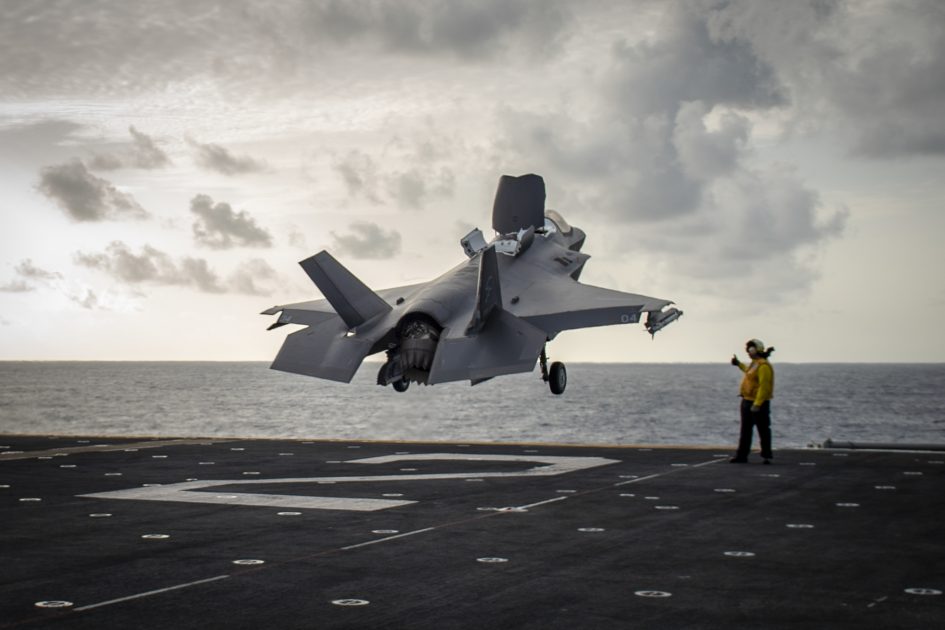
Another tidbit from yet another article from AvWeek is that over the next year and beyond Lockheed expects to deliver one F-35 (A,B or C) every three days before deliveries are to surge again closer to the one aircraft a day delivery target.Pratt & Whitney (P&W) is offering to upgrade the vertical thrust component of the propulsion system for the Lockheed MartinF-35B, offsetting the extra weight of proposed upgrades to the stealthy fighter’s mission systems.
More than 18 months ago, the supplier of the F135 engine first unveiled the Growth Option 1.0 proposal, which offers to increase the thrust of the F-35 in horizontal flight by 6-10%.
In addition to that package, P&W also has developed proposals called Growth Option 1.0A and Growth Option 1.0B, which are focused on increasing the vertical lift provided by the Rolls-Royce-supplied lift fan.
Both options were developed as the F-35 Joint Program Office considers Block 4 system upgrades that could increase the overall weight of the aircraft, thereby reducing the payload capacity of the F-35B during a vertical landing.
The Growth Option 1.0A involves a relatively straightforward change to the interface between the F135 engine and the lift fan, which results in a 2.5% increase in vertical thrust, a P&W official says.
Growth Option 1.0B offers a 5% jump in vertical thrust, but requires Rolls to alter the “inner workings” of the lift fan, P&W says.
Both options are informing an ongoing study by the Office of Naval Research on how to restore the “bring-back” capacity of the F-35B after the proposed Block 4 upgrades take effect.
Specifically, the proposed lift fan upgrades are intended to offset potential Block 4.2 mission systems upgrades, which are scheduled to enter service in 2024, P&W says.
In addition to Growth Options for the F-35B’s vertical lift system, P&W also is offering a “2.0” upgrade package for all F-35 variants to coincide with Block 4.2, the P&W official says.
In addition to offering the thrust and a potential 5% fuel efficiency improvement proposed with Growth Option 1.0, the 2.0 option raises the power and thermal management capacity of the engine, enabling the F-35 propulsion system to manage the additional heat generated by the improved electronics proposed under Block 4.2.
The Boeing Co., St. Louis, Missouri, has been awarded an indefinite-delivery/indefinite-quantity contract with an estimated ceiling of $9,202,568,686 for the Advanced Pilot Training aircraft and ground-based training systems. The contract provides for the anticipated delivery of 351 aircraft, 46 associated training devices, and other ancillary supplies and service (e.g., initial spares, support equipment, sustainment, and training). The contract includes the initial delivery order for engineering and manufacturing development of Advanced Pilot Training aircraft and ground-based training systems for $813,385,533. The maximum quantity of aircraft and training devices the Air Force can purchase under this indefinite-delivery/indefinite-quantity contract is 475 aircraft and 120 ground based training systems. Work will be performed in St. Louis, Missouri, and is expected to be complete by 2034. This award is the result of a competitive acquisition. Fiscal 2018 research, development, test and evaluation funds in the amount of $33,600,000 are being obligated on the first delivery order at the time of award. Air Force Life Cycle Management Center, Wright-Patterson Air Force Base, Dayton, Ohio, is the contracting activity (FA8617-18-D-6219).

Boeing had really good products for the defined roles on all three of those programs. Furthermore, they likely invested more to put forward a solution for the requirements likely because they needed these programs more than some of the others. On the T-X, they designed, developed and produce two prototypes of a clean sheet design that was likely the closest to the USAF requirements since they were starting from scratch. On the MQ-25, once Northrop was out, they were the only competitor to really design and build a prototype even though they had something that they had designed for the requirement earlier. Others basically had paper solutions.Chinmay wrote:Well that's a trifecta for Boeing, after the MQ-25 and Huey replacement contracts. Good way to keep all major contractors in business
.Reports are once again emerging from Japan that Lockheed Martin is pitching a highly modified version of its stealthy F-22 Raptor air superiority fighter to Tokyo for its next-generation fighter requirement. However, Lockheed Martin would first have to overcome the 1997 Obey Amendment, which prohibits export of the powerful high altitude supersonically cruising stealth fighter. Additionally, the company would have to undertake a painstaking process to restart a production line for an aircraft that has been out of production since 2012
USMC F-35B Lightning Crashes Near MCAS Beaufort, South Carolina: Pilot Ejects.
A U.S. Marine F-35B Lightning II Joint Strike Fighter has crashed near Beaufort Marine Corps Air Station outside of Beaufort, South Carolina on the U.S. East Coast. Reports indicate the pilot ejected from the aircraft. His condition is not known at this time.
MCAS Beaufort is home to Marine Fighter Attack Training Squadron 501 (VMFAT-501), the “Warlords”. The unit is a training squadron equipped with 20 F-35B Lightning II aircraft and serves as the Fleet Replacement Squadron.
This first-ever crash of an F-35 Joint Strike Fighter comes only one day after a U.S. Marine F-35B flew its first operational combat mission over Afghanistan.
This story will be updated as more information becomes available.

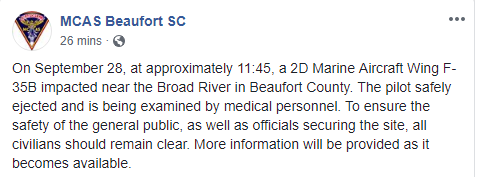
Not a trillion $SaiK wrote:That is like 1/4 billion gone in a jiffy. I was routing for F35b for IN Sea Harrier replacement
Was there not another incident (engine failure?) a few days ago ?brar_w wrote:First F-35 crash. Pilot (instructor pilot) was able to eject and is safe as per the USMC.
USMC F-35B Lightning Crashes Near MCAS Beaufort, South Carolina: Pilot Ejects.
A U.S. Marine F-35B Lightning II Joint Strike Fighter has crashed near Beaufort Marine Corps Air Station outside of Beaufort, South Carolina on the U.S. East Coast. Reports indicate the pilot ejected from the aircraft. His condition is not known at this time.
A Navy F-35C Lighting II Joint Strike Fighter made an emergency landing at Yosemite International Airport in Fresno on Monday afternoon due to a possible mechanical glitch, Navy officials in California confirmed Tuesday.
The unnamed pilot tried to troubleshoot the issue from the air but could not and landed the jet without injury at the civilian airport.
Manish_P wrote:Was there not another incident (engine failure?) a few days ago ?
Precautionary landings have happened earlier as well due to various reasons such as an alert warning that popped up but that too is routine and usually doesn't lead to a systemic fault being identified. When you have that many aircraft flying every day around the world these things will obviously happen. This, like I said earlier, will continue to happen as an F-35 is handed over to a customer every three days.Navy regulations mandate that pilots land aircraft when certain indicators pop and this problem appears to be “very minor,” Flanders added.